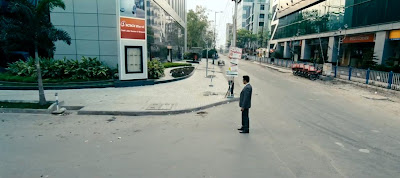by Tathagato
In popular social networking sites, I saw few photographs of 'Kolkata in making', probably from the British era which I hardly can relate to the present time. The photographs were mostly about building and roads or put together; of the landscape. Kolkata, the city of Joy has overcome a long odd two hundred years of journey and now she is having a makeover. Suddenly, I realized, there are a few things Kolkata still bears in it and that makes it different from other cosmopolitan cities.
A competition was announced on a social networking site to photograph Kolkata and I started following it silently. I wanted to observe Kolkata through the lens of others and it was to my immense surprise that, most of the photographs were on the identities of Kolkata. Let me explain, by identities I am pointing out to things like Trams and tram-lines near the Red Road areas, the Vidyasagar and Rabindra Bridge, Man-pulled Ricksaw, Kumartuli (the dedicated place where Idols are made) and Road-side tea stalls. And most of the photographs were in anything but color. What does that mean? Well, I am leaving it to you for a postmodern answer.
A well-circulated photo of Chowringhee Area of Kolkata on Facebook
Photo-credit : Anindita Majumder, a professional photographer and my friend.
Looking at the other side, films, indeed did a great job in documenting Kolkata. In a way this medium has captured brilliantly the culture or cultures of a city. Mrinal Sen in his trilogy on Kolkata mostly captured the political landscape whereas Satyajit Ray has sensed the economic and cultural shift in the city and captured it; in not less than four films. One of them which I personally like is Mahanagar; a 1963 film documenting Kolkata's changing cultural and economic landscape. I don't want to ruin your interest by telling the storyline, but here is a screen-shot which depicts the landscape of 'then Kolkata.'
Houses in Kolkata, 1960s : A Shot from the film Mahanagar, Satyajit Ray.
Houses in Kolkata, 1960s : A Shot from the film Mahanagar, Satyajit Ray.
Ray had a futuristic vision to anticipate ramifications of Globalization and to my understanding, it had been marvelously presented in this film.
And if now we look at the present Bengali films, many of them are documenting a kaleidoscopic cityscape of present time Kolkata.
Identity of a city mostly belongs to its tangible form, i.e. the Structures. If you think of New York, what comes to you is either the Statue of Liberty or few known epic buildings or may be few roads, if you've been there. Similarly, every city has its own and unique symbols. For Kolkata..... well do a Google search ....Victoria Memorial and the famous Howrah Bridge are there. Non-Bengali film makers often go for a shooting in Kolkata and we have seen, they will target these structures to represent the city. In Sujoy Ghose's film Kahani, probably for the first time we see Kolkata from a different vantage point where he wisely used another not-so-used prop i.e. Durga Puja.
From Ray to recent film makers there may be a gap of 50 years but by now, Kolkata has changed a lot, and in my words, Kolkata has undergone a 'Makeover'. If you get a chance to watch Maach Mishti & More, a 2013 film, it exactly starts with a narration of Kolkata and its changes along with a sort of graphic novel representation.
Narrating the Change: from the film Maach, Mishti & More ( Fish, Sweet and More) by Mainak Bhaumik
The narration delivered by a character in the film often compares the new city with the old one and also goes on to accept that he is loving these changes and getting accustomed to it. Kolkata is moving..... moving towards becoming a city with a rapid adaptation and manifestation of global culture.
Changing Cultural Landscape: from the film Maach, Mishti & More ( Fish, Sweet and More) by Mainak Bhaumik
The adjacent townships of Kolkata which are amazingly modern (or postmodern!!) in architecture as well as in lifestyle have an obvious impact on the city and on the audiences. Our lifestyle has changed significantly not only due to some economic factors but also because of the fact that we wanted the change. We were always aware of the facts about western culture and lifestyles; but adopting it explicitly; is a recent phenomenon, I would say.
Kolkata : Hopes and Bleaks : from the movie Aborto (2013) by Arindam Sil
I love the way my city has been captured even with a biased representation of a particular class, identity and ideology, leaving out other real problems. Kolkata, a juxtapose of modern and traditional, prospects and problems, hopes and bleaks, is out there and films are continually mapping the dynamics of its City-scape.
Author's Bio- Note:
Tathagato is, at present teaching in the Department of Humanities and Languages, Birla Institute of Technology and Science, Pilani, Rajasthan. He is trained as a Geographer and is presently doing an interdisciplinary research on 'urban culture'. In free time, he loves to cook, listen to music and enjoys going on long drive.








Thank you for providing clear information on this. you can also refer BBMP Approved Apartments in Bangalore
ReplyDelete